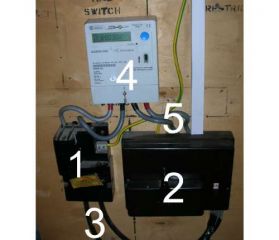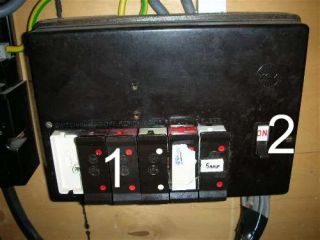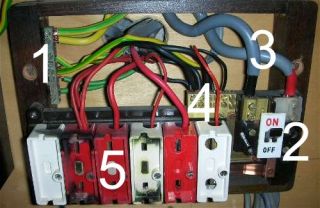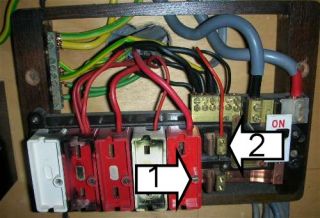Here we have a fused consumer unit in an older property, whilst consumer units of this type do what they are supposed to do they are often overloaded on a regular basis. Safety can be greatly improved by getting it replaced with a modern split way consumer unit. Although you can change the consumer unit yourself (as long as you notify building control) It is a job best left to professional electricians.
| Before working on any electrical circuit you must ensure that it is isolated correctly and cannot accidentally be switched back on. Please read the article on safe isolation procedures before doing any electrical work. If you are not 100% certain what you are doing call a qualified electrician. Building regulations are changing all the time and modifying your home electrics could be against new rules and could invalidate your home insurance, if in doubt check first! |

1.Sealed unit incorporating the main fuse, which is normally rated at 100 Amps.
2.Consumer unit (fused type)
3.Service Cable
4.Meter.
5.Meter tails (normally 25mm2)
Electricity travels from the service cable where it enters the sealed unit. The positive conductor (phase) is connected to a fuse, known as the main fuse or service cut out. The phase and Neutral conductors leave the sealed unit and are connected to the meter via meter tails. The meter tails then go from the meter to the consumer unit. Should your consumer unit need changing then it is a good idea to get the regional electricity board to fit a double pole isolator switch between the meter tails and the consumer unit.
The main fuse or service cut out should only be removed by the regional electricity company as it is their property, although many electricians will remove the fuse themselves.
DO NOT TAMPER WITH THE MAIN FUSE, SERVICE CABLE, METER TAILS OR THE SEALED UNIT. TURNING OFF THE SWITCH ON THE CONSUMER UNIT DOES NOT ISOLATE ANY OF THE ABOVE MENTIONED. YOU MUST ENSURE THAT THE MAIN SWITCH IS SWITCHED OFF BEFORE HANDLING FUSES OR REMOVING THE CONSUMER UNIT COVER.

This is the consumer unit with the fuse cover removed
1.Fuses
2.Main switch
When consumer units are wired up it is accepted practice to put the fuses in descending order from the main switch, so that the largest fuse will be closest to the main switch and the smallest fuse will be farthest away. There is some debate as to whether this make a difference or if it is purely for aesthetical appearance but it is common practice to ensure that the fuses are in descending order away from the main switch.

This is the consumer unit with the fuses and cover removed.
1.Earthing Terminal.
2.Main switch.
3.Meter tails (these are permanently live unless an isolator has been fit between the consumer unit and meter tails, unless the main fuse (service cut out) has been removed)
4.Neutral Terminal.
5.Fuse carriers
You can see that this unit has been overloaded as there are scorch marks around a couple of the fuses. Overloaded consumer units can be a fire risk, I have seen these dripping hot metal onto carpets in the past. Although this one is not really that dangerous it needs updating at the earliest opportunity. The fuse carriers are coloured to help with fuse replacement. The white carriers are 5 Amps and the red ones are 30 Amps.

1.The fuse carriers are removed by undoing the small screw.
2.This exposes the terminal where circuit wires can be connected. When the main switch is switched back on the electricity passes through the bus bar at the bottom of the consumer unit. The fuse then protects the circuit with the correct amperage fuse.



